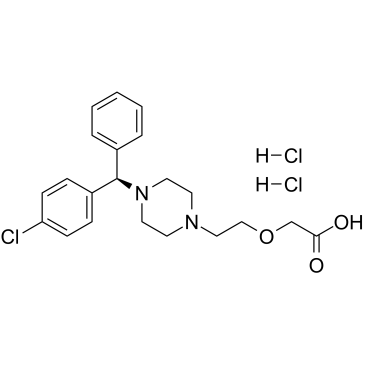130018-87-0
| Name | Levocetirizine Dihydrochloride |
|---|---|
| Synonyms |
Xyzall
EINECS 200-659-6 (R)-Cetirizine Dihydrochloride Levocetirizine dihydrochloride (2-{4-[(R)-(4-Chlorphenyl)(phenyl)methyl]piperazin-1-yl}ethoxy)essigsäuredihydrochlorid MFCD07366507 (-)-Cetirizine dihydrochloride Levocetirizine 2HCl Xusal (2-{4-[(R)-(4-Chlorophenyl)(phenyl)methyl]-1-piperazinyl}ethoxy)acetic acid dihydrochloride 2-[2-[4-[(R)-(4-Chlorophenyl)phenylmethyl]piperazin-1-yl]ethoxy]acetic Acid Dihydrochloride Xyzal acide (2-{4-[(R)-(4-chlorophényl)(phényl)méthyl]pipérazin-1-yl}éthoxy)acétique dichlorhydrate acetic acid, [2-[4-[(R)-(4-chlorophenyl)phenylmethyl]-1-piperazinyl]ethoxy]-, dihydrochloride Acetic acid, 2-[2-[4-[(R)-(4-chlorophenyl)phenylmethyl]-1-piperazinyl]ethoxy]-, hydrochloride (1:2) (2-{4-[(R)-(4-Chlorophenyl)(phenyl)methyl]piperazin-1-yl}ethoxy)acetic acid dihydrochloride |
| Description | Levocetirizine dihydrochloride ((R)-Cetirizine dihydrochloride) is a third-generation peripheral H1-receptor antagonist. Levocetirizine dihydrochloride is an antihistaminic agent which is the R-enantiomer of Cetirizine. Levocetirizine dihydrochloride has a higher affinity for the histamine H1-receptor than (S)-Cetirizine and can effectively treat allergic rhinitis and chronic idiopathic urticaria[1]. |
|---|---|
| Related Catalog | |
| In Vivo | Levocetirizine (0.4 mg/kg; oral administration; male Sprague-Dawley rats) treatment shows that the Cmax, AUC0-t , AUC0-∞ and t1/2 are 0.34 μg/mL, 3.26 μg h/mL, 3.67 μg h/mL and 2.34 hours, respectively in Sprague-Dawley rats[1]. Animal Model: 30 male Sprague-Dawley rats (8 weeks old; 200-250 g)[1] Dosage: 0.4 mg/kg Administration: Oral administration (Pharmacokinetic Analysis) Result: The Cmax, AUC0-t , AUC0-∞ and t1/2 were 0.34 μg/mL, 3.26 μg h/mL, 3.67 μg h/mL and 2.34 hours, respectively. |
| References |
| Boiling Point | 542.1ºC at 760 mmHg |
|---|---|
| Melting Point | 215-220ºC |
| Molecular Formula | C21H27Cl3N2O3 |
| Molecular Weight | 461.810 |
| Flash Point | 281.6ºC |
| Exact Mass | 460.108734 |
| PSA | 53.01000 |
| LogP | 4.62800 |
| Storage condition | room temp |
| Symbol |


GHS07, GHS09 |
|---|---|
| Signal Word | Warning |
| Hazard Statements | H302-H400 |
| Precautionary Statements | P273 |
| Hazard Codes | Xn,N |
| Risk Phrases | 22-50/53 |
| Safety Phrases | 60-61 |
| RIDADR | UN 3077 9 / PGIII |
| HS Code | 2933990090 |
| HS Code | 2933599090 |
|---|---|
| Summary | 2933599090. other compounds containing a pyrimidine ring (whether or not hydrogenated) or piperazine ring in the structure. VAT:17.0%. Tax rebate rate:13.0%. . MFN tariff:6.5%. General tariff:20.0% |

